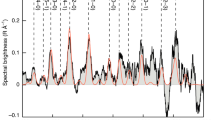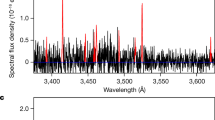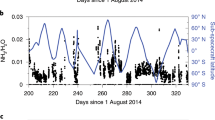Abstract
Comets spend most of their lives at large distances from any star, during which time their interior compositions remain relatively unaltered. Cometary observations can therefore provide direct insight into the chemistry that occurred during their birth at the time of planet formation1. To date, there have been no confirmed observations of parent volatiles (gases released directly from the nucleus) of a comet from any planetary system other than our own. Here, we present high-resolution interferometric observations of 2I/Borisov, the first confirmed interstellar comet, obtained using the Atacama Large Millimeter/submillimeter Array (ALMA) on 15–16 December 2019. Our observations reveal emission from hydrogen cyanide (HCN) and carbon monoxide (CO) coincident with the expected position of 2I/Borisov’s nucleus, with production rates Q(HCN) = (7.0 ± 1.1) × 1023 s−1 and Q(CO) = (4.4 ± 0.7) × 1026 s−1. While the HCN abundance relative to water (0.06–0.16%) appears similar to that of typical, previously observed comets in our Solar System, the abundance of CO (35–105%) is among the highest observed in any comet within 2 au of the Sun. This shows that 2I/Borisov must have formed in a relatively CO-rich environment—probably beyond the CO ice-line in the very cold, outer regions of a distant protoplanetary accretion disk, as part of a population of small icy bodies analogous to our Solar System’s own proto-Kuiper belt.
This is a preview of subscription content, access via your institution
Access options
Access Nature and 54 other Nature Portfolio journals
Get Nature+, our best-value online-access subscription
$29.99 / 30 days
cancel any time
Subscribe to this journal
Receive 12 digital issues and online access to articles
$119.00 per year
only $9.92 per issue
Buy this article
- Purchase on Springer Link
- Instant access to full article PDF
Prices may be subject to local taxes which are calculated during checkout




Similar content being viewed by others
Data availability
This work makes use of ALMA dataset ADS/JAO.ALMA#2019.01008.T, which is available for download from the ALMA Science Archive (http://almascience.nrao.edu/aq/) following a 1-year proprietary period. All data that support the findings of this study are available on resonable request from the corresponding author.
Code availability
The radiative transfer model required to reproduce the results of this study is available on reasonable request from the corresponding author.
References
Mumma, M. J. & Charnley, S. B. The chemical composition of comets—emerging taxonomies and natal heritage. Annu. Rev. Astron. Astrophys. 49, 471–524 (2011).
Cleeves, L. I. et al. Constraining gas-phase carbon, oxygen, and nitrogen in the IM Lup protoplanetary disk. Astrophys. J. 865, 155–166 (2018).
Podio, L. et al. Organic molecules in the protoplanetary disk of DG Tauri revealed by ALMA. Astron. Astrophys. 623, L6 (2019).
Bergner, J. B. et al. A survey of C2H, HCN, and C18O in protoplanetary disks. Astrophys. J. 876, 25 (2019).
Walsh, C. et al. Complex organic molecules in protoplanetary disks. Astron. Astrophys. 563, A33 (2014).
Drozdovskaya, M. N. et al. Cometary ices in forming protoplanetary disc midplanes. Mon. Not. R. Astron. Soc. 462, 977–993 (2016).
Lodders, K. Jupiter formed with more tar than ice. Astrophys. J. 611, 587–597 (2004).
Öberg, K. I., Murray-Clay, R. & Bergin, E. A. The effects of snowlines on C/O in planetary atmospheres. Astrophys. J. Lett. 743, L16 (2011).
Dodson-Robinson, S. E., Willacy, K., Bodenheimer, P., Turner, N. J. & Beichman, C. A. Ice lines, planetesimal composition and solid surface density in the solar nebula. Icarus 200, 672–693 (2009).
Bailer-Jones, C. A. L., Farnocchia, D., Ye, Q., Meech, K. J. & Micheli, M. A search for the origin of the interstellar comet 2I/Borisov. Astron. Astrophys. 634, A14 (2020).
Torbett, M. V. Capture of V∞ = 20 km s−1 interstellar comets by three-body interactions in the planetary system. Astron. J. 92, 171–175 (1986).
The ’Oumuamua ISSI Team. The natural history of ’Oumuamua. Nat. Astron. 3, 594–602 (2019).
Micheli, M. et al. Non-gravitational acceleration in the trajectory of 1I/2017 U1 (’Oumuamua). Nature 559, 223–226 (2018).
Fitzsimmons, A. et al. Detection of CN gas in interstellar object 2I/Borisov. Astron. Astrophys. 885, L9 (2019).
Opitom, C. et al. 2I/Borisov: a C2-depleted interstellar comet. Astron. Astrophys. 631, L8 (2019).
Xing, Z., Bodewits, D., Noonan, J. & Bannister, M. Water production rates and activity of interstellar comet 2I/Borisov. Astrophys. J. Lett. (in the press).
McKay, A., Cochran, A., Dello Russo, N. & DiSanti, M. Detection of a water tracer in interstellar comet 2I/Borisov. Astrophys. J. Lett. 889, L10 (2020).
Jewitt, D. & Luu, J. Initial characterization of interstellar comet 2I/2019 Q4 (Borisov). Astrophys. J. Lett. 886, L29 (2019).
Fray, N., Bénilan, Y., Cottin, H., Gazeau, M.-C. & Crovisier, J. The origin of the CN radical in comets: a review from observations. Planet. Space Sci. 53, 1243–1262 (2005).
Bockelée-Morvan, D. & Biver, N. The composition of cometary ices. Phil. Trans. R. Soc. A 375, 20160252 (2017).
Cordiner, M. A. et al. ALMA autocorrelation spectroscopy of comets: the HCN/H13CN ratio in C/2012 S1 (ISON). Astrophys. J. Lett. 870, L26 (2019).
Paganini, L. et al. C/2013 R1 (Lovejoy) at IR wavelengths and the variability of CO abundances among Oort Cloud comets. Astrophys. J. 791, 122 (2014).
McKay, A. J. et al. The peculiar volatile composition of CO-dominated comet C/2016 R2 (PanSTARRS). Astron. J. 158, 128–152 (2019).
Biver, N. et al. The extraordinary composition of the blue comet C/2016 R2 (PanSTARRS). Astron. Astrophys. 619, A127 (2018).
Bockelée-Morvan, D. et al. A study of the distant activity of comet C/2006 W3 (Christensen) with Herschel and ground-based radio telescopes. Astron. Astrophys. 518, L149 (2010).
Wierzchos, K. & Womakck, M. C/2016 R2 (PANSTARRS): a comet rich in CO and depleted in HCN. Astron. J. 156, 34–40 (2018).
Womack, M., Sarid, G. & Wierzchos, K. CO in distantly active comets. Publ. Astron. Soc. Pac. 129, 031001 (2017).
Ootsubo, T. et al. AKARI near-infrared spectroscopic survey for CO2 in 18 comets. Astrophys. J. 752, 15 (2012).
Fitzsimmons, A. et al. Spectroscopy and thermal modelling of the first interstellar object 1I/2017 U1 ‘Oumuamua. Nat. Astron. 2, 133–137 (2018).
Stern, S. A. ISM-induced erosion and gas-dynamical drag in the Oort Cloud. Icarus 84, 447–466 (1990).
Bergin, E. & Cleeves, L. I. in Handbook of Exoplanets (eds Deeg, H. J. & Belmonte, J. A.) 2221–2250 (Springer, 2018).
Eistrup, C., Walsh, C. & van Dishoeck, E. F. Molecular abundances and C/O ratios in chemically evolving planet-forming disk midplanes. Astron. Astrophys. 613, A14 (2018).
Qi, C. et al. Imaging of the CO snow line in a solar nebula analog. Science 341, 630–632 (2013).
Morbidelli, A. & Nesvorný, D. in The Trans-Neptunian Solar System (eds Prialnik, D. et al.) 25–29 (Elsevier, 2019).
Gladman, B., Marsden, B. G. & VanLaerhoven, C. in The Solar System Beyond Neptune (eds Barucci, M. A. et al.) 43–57 (Springer, 2008).
Zhang, K. E., Bergin, E. A., Schwarz, K., Krijt, S. & Ciesla, F. Systematic variations of CO gas abundance with radius in gas-rich protoplanetary disks. Astrophys. J. 883, 98 (2019).
Qi, C. et al. Probing CO and N2 snow surfaces in protoplanetary disks with N2H+ emission. Astrophys. J. 882, 160 (2019).
Andrews, S. Observations of protoplanetary disk structures. Annu. Rev. Astron. Astrophys. (in the press).
Zhang, S. et al. The Disk Substructures at High Angular Resolution Project (DSHARP). VII. The planet–disk interactions interpretation. Astrophys. J. Lett. 869, L47 (2018).
Stevenson, D. J. & Lunine, J. I. Rapid formation of Jupiter by diffusive redistribution of water vapor in the solar nebula. Icarus 75, 146–155 (1988).
De Sanctis, M. C., Capria, M. T. & Coradini, A. Thermal evolution and differentiation of Edgeworth-Kuiper Belt objects. Astron. J. 121, 2792–2799 (2001).
Dello Russo, N., Kawakita, H., Vervack, R. J. & Weaver, H. Emerging trends and a comet taxonomy based on the volatile chemistry measured in thirty comets with high-resolution infrared spectroscopy between 1997 and 2013. Icarus 278, 301–332 (2016).
Jaeger, S. in Astronomical Data Analysis Software and Systems XVII (Astronomical Society of the Pacific Conference Series) Vol. 394 (eds Argyle, R. W. et al.) 623–626 (Astronomical Society of the Pacific, 2008).
Remijan, A. et al. ALMA Technical Handbook Doc 7.3, ver. 1.1 (ALMA, 2019).
Downes, D. in Diffraction-Limited Imaging with Very Large Telescopes (eds Alloin, D. M. & Mariotti, J.-M.) 53–84 (Springer, 1989).
Brinch, C. & Hogerheijde, M. R. LIME—a flexible, non-LTE line excitation and radiation transfer method for millimeter and far-infrared wavelengths. Astron. Astrophys. 523, A25 (2010).
Schöier, F. L., van der Tak, F. F. S., van Dishoeck, E. F. & Black, J. H. An atomic and molecular database for analysis of submillimetre line observations. Astron. Astrophys. 432, 369–379 (2005).
Huebner, W. F. & Mukherjee, J. Photoionization and photodissociation rates in solar and blackbody radiation fields. Planet. Space Sci. 106, 11–45 (2015).
Biver, N. et al. Long-term monitoring of the outgassing and composition of comet 67P/Churyumov-Gerasimenko with the Rosetta/MIRO instrument. Astron. Astrophys. 630, A19 (2019).
Cochran, A. & Schleicher, D. G. Observational constraints on the lifetime of cometary H2O. Icarus 105, 235–253 (1993).
Biver, N. et al. Spectroscopic monitoring of comet C/1996 B2 (Hyakutake) with the JCMT and IRAM Radio Telescopes. Astrophys. J. 118, 1850–1872 (1999).
Biver, N. et al. Submillimetre observations of comets with Odin: 2001-2005. Planet. Space Sci. 55, 1058–1068 (2007).
Hartogh, P. et al. HIFI observations of water in the atmosphere of comet C/2008 Q3 (Garradd). Astron. Astrophys. 518, L150 (2010).
Jehin, E. et al. TRAPPIST: TRAnsiting Planets and PlanetesImals Small Telescope. Messenger 145, 2–6 (2011).
Farnham, T. L., Schleicher, D. G. & A’Hearn, M. F. The HB narrowband comet filters: standard stars and calibrations. Icarus 147, 180–204 (2000).
Opitom, C. Monitoring of the chemical composition of comets in the framework of the TRAPPIST survey. PhD Thesis, Université de Liège, Belgium (2016).
Moulane, Y. et al. Monitoring of the activity and composition of comets 41P/Tuttle-Giacobini-Kresak and 45P/Honda-Mrkos-Pajdusakova. Astron. Astrophys. 619, A156 (2018).
Acknowledgements
We thank R. Simon for setting up the ALMA scheduling blocks, and D. Cruikshank for discussions on the composition of Kuiper belt objects. This work was supported by the National Science Foundation (under grant no. AST-1614471), and by the Planetary Science Division Internal Scientist Funding Program through the Fundamental Laboratory Research (FLaRe) work package, as well as the NASA Astrobiology Institute through the Goddard Center for Astrobiology (proposal 13-13NAI7-0032). Part of this research was carried out at the Jet Propulsion Laboratory, California Institute of Technology, under a contract with the National Aeronautics and Space Administration. ALMA is a partnership of ESO, NSF (USA), NINS (Japan), NRC (Canada), NSC and ASIAA (Taiwan) and KASI (Republic of Korea), in cooperation with the Republic of Chile. The JAO is operated by ESO, AUI/NRAO and NAOJ. The NRAO is a facility of the National Science Foundation operated under cooperative agreement by Associated Universities, Inc. TRAPPIST is a project funded by the Belgian Fonds (National) de la Recherche Scientifique (Fonds de la Recherche Scientifique–FNRS) under grant FRFC 2.5.594.09.F. E.J. is a FNRS Senior Research Associate. N.X.R. was supported by the NASA Postdoctoral Program, administered by the Universities Space Research Association.
Author information
Authors and Affiliations
Contributions
M.A.C. performed the data reduction and radiative transfer modelling, and generated most of the text and figures. S.N.M. obtained the ALMA observations and helped write the manuscript. N.B. performed independent radiative transfer calculations and statistical comparisons. D.B.-M. made Fig. 4. E.A.B. wrote part of the interpretation. N.X.R. worked on Supplementary Table 1, and generated upper limits. A.J.R. helped obtain the observations and identify spectral lines. E.J. provided ancillary optical data from TRAPPIST. S.B.C., J.C., D.C.L., L.P., Y.-J.K., J.B. and M.J.M. contributed to the interpretation and helped write the manuscript.
Corresponding author
Ethics declarations
Competing interests
The authors declare no competing interests.
Additional information
Publisher’s note Springer Nature remains neutral with regard to jurisdictional claims in published maps and institutional affiliations.
Supplementary information
Supplementary Information
Supplementary Fig. 1, Tables 1–2 and references.
Rights and permissions
About this article
Cite this article
Cordiner, M.A., Milam, S.N., Biver, N. et al. Unusually high CO abundance of the first active interstellar comet. Nat Astron 4, 861–866 (2020). https://doi.org/10.1038/s41550-020-1087-2
Received:
Accepted:
Published:
Issue Date:
DOI: https://doi.org/10.1038/s41550-020-1087-2
This article is cited by
-
Reply to: Accelerating ‘Oumuamua with H2 is challenging
Nature (2023)
-
Iron and nickel vapours are present in most comets
Nature (2021)
-
Compact pebbles and the evolution of volatiles in the interstellar comet 2I/Borisov
Nature Astronomy (2021)
-
Gaseous atomic nickel in the coma of interstellar comet 2I/Borisov
Nature (2021)



